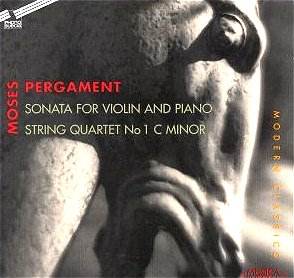Pergament is written up in Phono-Suecia's notes as
a modernist and as a focus for Nordic and Jewish musical legacies -
the latter only suggested in the final movement of the quartet and then
only in the most general terms. The 'modernist' tag raised expectations
of dodecaphonic somersaults. Not a bit of it ... at least not in these
two pieces. If anything Pergament's mode of speech is centred on the
luminous Gallic ecstasy of people like Lekeu, Howells (as in the Piano
Quartet and early violin sonatas), Ireland, Dunhill, Cras, Vierne and
Max d'Ollone. French influences are not unheard of among Scandinavian's
- Uuno Klami was somewhat undermined by the French influence (as in
his Second Piano Concerto Nuit à Montmartre) and Gösta
Nystroem's Viola Concerto is titled Hommage à la France.
The notes tell us that Pergament invited Nystroem to come to Paris and
that soon after they were joined by Hilding Rosenberg (whose symphonies
are to be recorded complete by Bis).
Pergament makes succulent hay with the language. It
is not all ecstatic sunrises and grass crested collines. The scherzo
is touched with a macabre wand but it is the macabre of Ravel as in
Skarbo. There is no hint of Sibelius in this nor of the dissonances
employed by contemporaries such as Kallstenius. Forsberg, a pianist
of the first order, is excellent both in the stone-hewn declamatory
material of the ten minute finale and in the silverpoints of the first
two movements. Sparf has a slender and shapely tone and he is alive
to the 'dark dancer' elements. He reminds me somewhat of the approach
I have heard applied successfully to broadly similar works such as the
Bax, Ireland and Dunhill second violin sonatas.
Pergament was Finnish-born, German-educated and Sweden-resident
and in 1919 took Swedish citizenship. He idolised Sibelius and Wagner.
While the latter took Teuton mythopoeia as his quarry for plot and ambience
Pergament turned to the Bible. His works include Kelantems and Eldeling
(1920-27), the choral symphony The Jewish Song (1944), the
oratorio The Seven Deadly Sins (1949) and an as yet unperformed
symbolist opera Abram's Erwachen (1966-73).
The String Quartet poses a greater challenge bristling
with a profusion of melodic lines and dense with activity. It is comparable
to the richness of the string quartets of Bernard van Dieren, John Foulds
(especially the masterly Intimo on Pearl) and Karl Weigl (whose
gemütlich Viennese coffee-house manner is evoked in the folk song
variations of the second movement), the orchestral writing of Joseph
Marx and the instumental writing of Kaikhosru Shapurji Sorabji. Pergament
has taken an imprint from Schoenberg's Verklärte Nacht also.
The quartet is intriguing and has many coups of the imagination but
it does not have the concentration and inevitability of the sonata.
Another horizon-broadening lesson for this listener
and the disc is highly recommendable to those who are attracted by the
litany of names I have mentioned.
Rob Barnett


